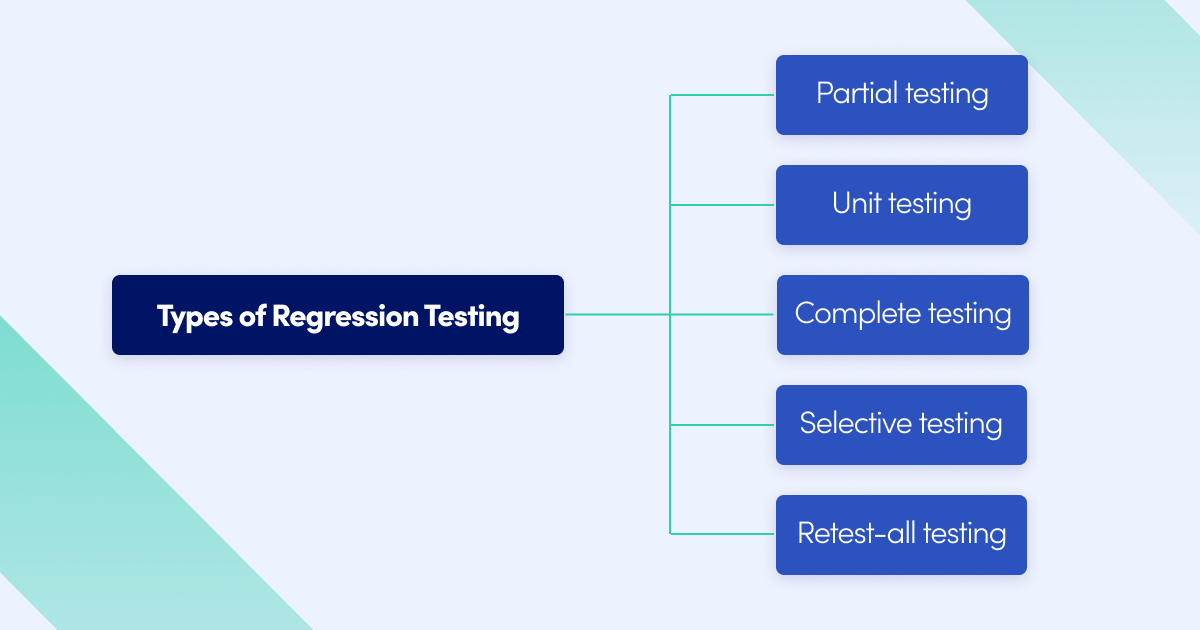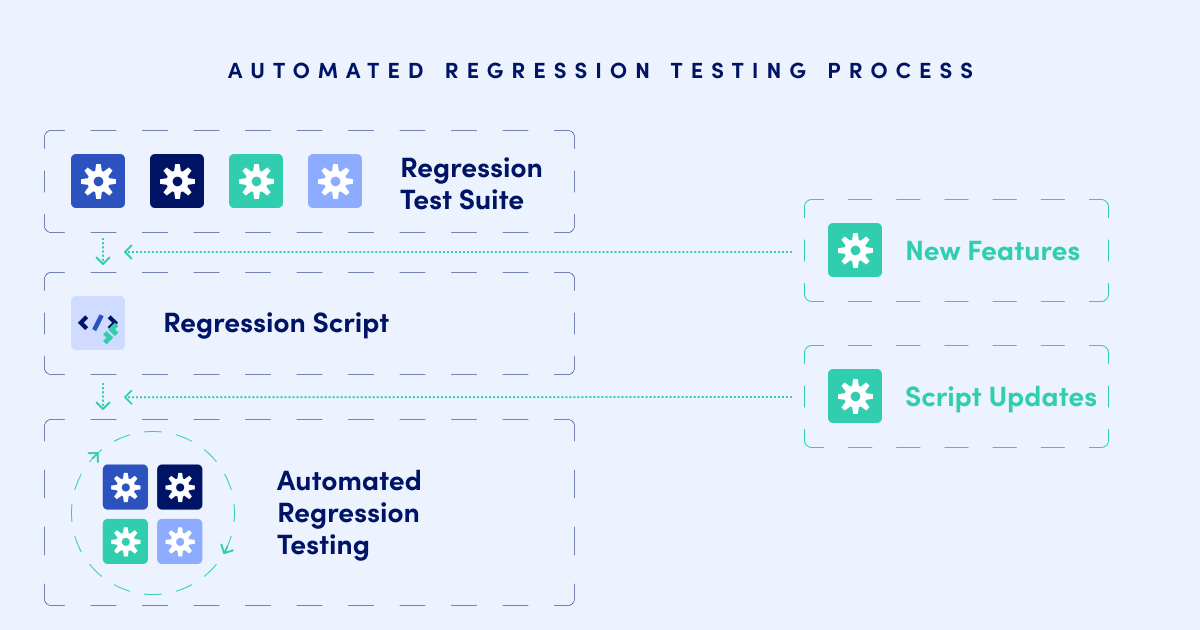
There is no doubt about it, regression testing is a crucial aspect of software development. It ensures that existing features continue to work as expected after changes are made to the code base.
However, regression testing is a broad concept. In this article, we will review five types of regression testing that developers and QA specialists usually use to maintain software quality and integrity.
From unit regression testing to complete testing, each method offers unique benefits to ensure the smooth evolution of software projects.

Starting with the basics: what is regression testing?
Imagine you're developing a software application. Its development doesn't stop with the product rollout. Instead, the application requires ongoing improvement and enhancement, incorporating new features to evolve and meet user needs.
Code changes are inevitable. Therefore, when making changes to the code base, such as fixing bugs, or adding new features, you need to make sure that the existing functionality continues to work as expected. This is where regression testing saves the day. It's like double-checking your work to make sure that everything is still working smoothly.
When to use regression tests:- Code changes
Every code modification requires regression tests to verify that the changes haven't adversely affected other components of the system. Otherwise, the entire application may collapse like a house of cards, leading to potential issues down the line.
- Agile development
Agile methodologies are about frequent code changes. That’s why regression testing is integrated into development cycles to ensure that modifications in one iteration don't affect previously tested components.
- Release preparation
Before each software release, the running of regression tests verifies the application's overall stability, ensuring that new features don't disrupt existing functionalities.
ProTip:
To cope with frequent releases and updates, especially in Dynamics 365, it's recommended to prioritize automation-driven testing strategies, allocating at least 50% of efforts to automation. This approach ensures adaptability to frequent system changes and maintains the system's robustness.

Why is it important?
- It ensures that existing functionalities remain intact through changes made during the development process.
- Regression tests help identify and fix defects (aka regressions) early in the development lifecycle.
- It maintains overall software quality, enhancing the user experience and minimizing disruptions to critical business operations.
- It provides confidence to stakeholders, including developers, testers, and end-users, that the software continues to meet its intended requirements and performs reliably over time.
Unit regression testing
Unit regression testing focuses on testing individual units or components of the software.
It involves re-executing test cases specifically designed to verify the functionality of these units, ensuring that they still perform as expected despite any modifications to the codebase.
Suppose you're working on a web application, and you've recently made changes to a specific function that calculates shipping costs. After making these changes, you run unit regression tests that specifically target this shipping cost calculation feature. These test cases verify that the function produces accurate results under various scenarios (different item quantities, shipping destinations, shipping methods, etc.)
Why unit regression testing is useful:
- Precision testing
Unit regression testing isolates specific software units or components, aiding in the pinpointing of “minor” regressions introduced by recent changes. - Early issue detection
Conducting tests on individual units early in development helps identify and resolve defects before they escalate to higher testing levels. - Enhanced software maintainability
By ensuring the functionality of individual units' post-changes, this type of testing bolsters software maintainability and stability.
Partial regression testing
Partial regression testing focuses on testing only a subset of test cases that are directly impacted by recent changes to the software, rather than retesting all functionalities.
For example, if updates are made to the login functionality of a mobile app, partial regression testing would involve running test cases related to user authentication and login procedures, without retesting unrelated functionalities like settings, profile management, etc.
Why partial regression testing is useful:
- Targeted validation
Partial regression testing focuses testing efforts on specific areas of the software affected by recent changes. This narrowly focused approach helps save time and resources compared to retesting the entire application. - Faster feedback loop
In this case, regression tests enable quicker feedback on the impact of changes by concentrating testing efforts on areas directly affected by modifications. This facilitates faster release cycles and allows teams to address any regressions or defects promptly. - Scalability
As software projects grow in complexity (as they do in the long run), partial regression testing offers a scalable approach to testing, allowing teams to maintain a balance between thorough validation and efficient testing practices as the application evolves.
Retest-all regression testing
In comparison with unit testing, retest-all regression testing (or full testing) implies a more comprehensive approach where all test cases from the existing test suite are executed again, regardless of whether they are directly impacted by recent changes to the software.
For example, during retest-all regression testing for an e-commerce website, all existing test cases are rerun to validate various functionalities, including product browsing, account management, payment processing, etc. This comprehensive approach ensures that recent changes to the checkout process haven't caused unexpected issues elsewhere on the site.
Why retest-all regression testing is useful:
- Comprehensive validation
Retest-all regression tests ensure that the entire software system is thoroughly validated after making changes. - Risk mitigation
By testing all functionalities at once (even those not directly impacted by recent changes), conducting regression tests helps mitigate the risk of unintended consequences in other areas of the software. - Compliance requirements
In highly regulated and intricate industries such as healthcare or finance, retest-all regression testing may be necessary to comply with stringent quality assurance standards and regulatory requirements.
Complete regression testing
Complete regression testing implies thoroughly testing all aspects of the software (functional and non-functional ones). Unlike retest-all testing, it may go beyond retesting existing functionalities (test cases), including additional checks such as performance testing, security testing, and compatibility testing.
For example, complete-related regression tests are used during the final stages of software development before a major release or deployment. It ensures that all changes and enhancements made throughout the development cycle have not introduced any regressions or defects and that the software meets all requirements and specifications.
Why complete regression testing is useful:
- Ensures comprehensive validation of the entire software system, including all functionalities and aspects.
- Identifies any regressions or defects that may have been introduced by recent changes or updates.
- Helps mitigate risks associated with software changes and ensures that the software meets all quality standards and requirements.
Selective regression testing
Selective regression testing involves choosing specific test cases from the regression test suite based on the areas of the software affected by recent changes, rather than retesting all functionalities.
For example, in an e-commerce website, the testing team might concentrate solely on testing the checkout process following updates made to enhance user experience and streamline payment flow. Instead of running the entire regression test suite, only test cases related to that module or feature are executed to verify its functionality.
Why selective regression testing is useful:
- Saves time and resources by focusing testing efforts on areas directly impacted by changes, reducing the overall testing effort.
- Enables quicker feedback on the impact of modifications, facilitating faster release cycles.
- Helps maintain a balance between thorough validation and efficient testing practices, particularly in large and complex software systems.
Ultimately, the different types of regression testing outlined in the article serve a common purpose: to safeguard the functionality of a system amidst changes. Whether unit, partial, full, or selective regression testing, the overarching goal remains unchanged - to ensure that the system performs as expected post-modifications.
By embracing these testing methods, software teams can fortify the integrity and reliability of their systems throughout the development lifecycle.
